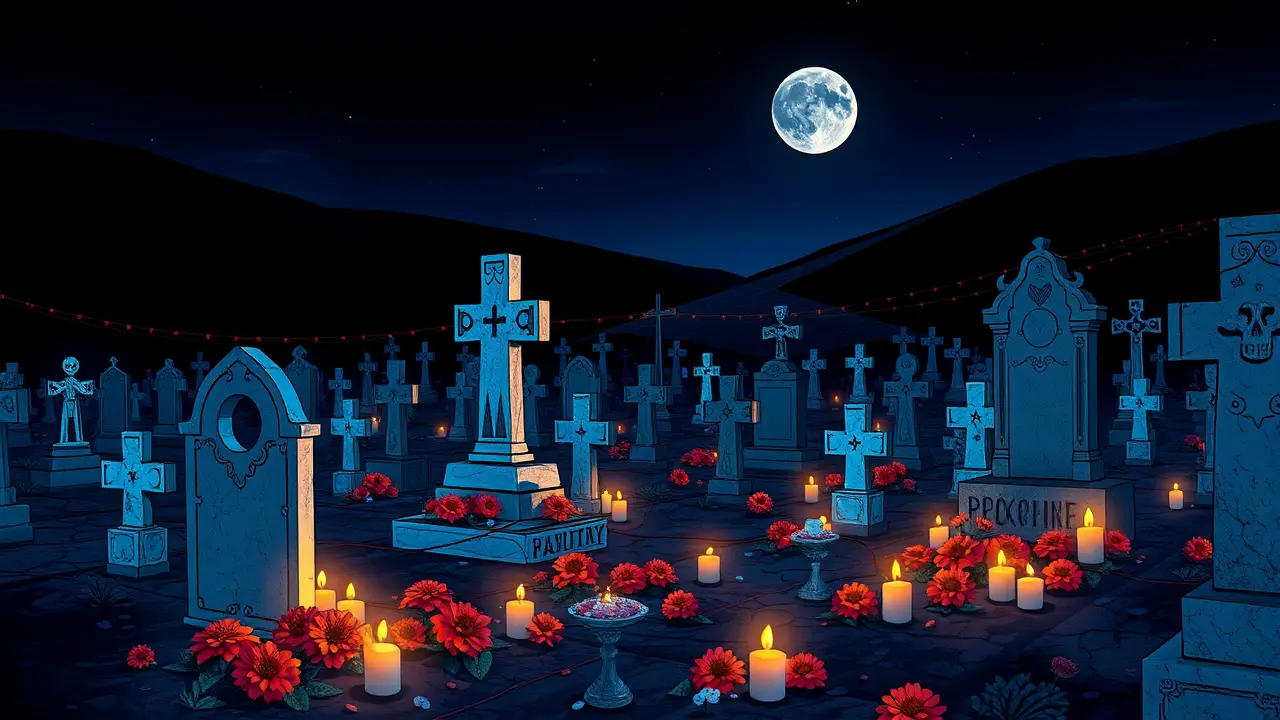
Entertainmenttheatre & artsFestivals and Openings
Mexico's Day of the Dead: A Night for Returning Souls.
LA
Laura Bennett
10 hours ago7 min read
In the small, highland town of Arocutin, nestled in the western Mexican state of Michoacán, the boundary between the living and the departed softens into something permeable, almost tender, for one profound night each year. Here, the ancient Día de los Muertos is not a somber occasion of mourning but a vibrant, communal welcome, a heartfelt reunion where families, armed with patience and love, spend the entire night in cemeteries transformed by the warm, flickering glow of countless candles.I spoke with Elena, a grandmother whose hands, weathered from a life of work, meticulously arranged bright orange cempasúchil marigolds on her parents' grave, their pungent scent believed to guide the souls home. 'It is not that we believe they might come,' she told me, her voice steady and sure in the quiet dark, 'We know they are here.We feel them in the cool night air, we hear them in the rustle of the leaves. We stay so they are not lonely on their long journey.' This is the core of the tradition, a beautiful syncretism that speaks volumes about the human need for connection. The practice is a palimpsest of history, with its roots deeply embedded in Indigenous rituals dating back over 3,000 years to the Aztecs, who dedicated an entire month to the goddess Mictecacihuatl, the Lady of the Dead, and celebrated the cyclical nature of life and death.Then came the Spanish conquistadors, armed with cross and sword, who sought to erase these 'pagan' beliefs. In a remarkable act of cultural resilience, the people did not abandon their customs but instead layered them, folding them into the Catholic calendar's All Saints' and All Souls' Days.The result is not a dilution but a strengthening; the ofrendas, or altars, in homes are laden with both the crucifix and the sugar skulls, the copal incense used in pre-Hispanic ceremonies rising alongside prayers to Catholic saints. It’s a fascinating psychological and sociological phenomenon—a collective, culturally-sanctioned space to process grief not with silence, but with music, food, and color.Anthropologists point to this as a uniquely healthy approach to bereavement, where the deceased remain part of the social fabric. The ofrenda is a deeply personal tableau, each element a sensory trigger for the returning spirit: a glass of water to quench the thirst of the long journey, a plate of their favorite mole or tamales, a shot of tequila, the sweet pan de muerto, and photographs that bridge the decades.For the younger generation, like Elena's university-bound grandson Carlos, the night is a tether to his identity. 'In the city, death is hidden away, something clinical and scary,' he shared, adjusting a candle that had flickered in the breeze.'But here, it's just… family. It reminds me who I am and where I come from.' This living tradition, however, faces its own modern challenges. Commercialization and the global popularity of spectacles like the James Bond film 'Spectre' have created a tourist-driven version of the celebration, particularly in Mexico City, which can sometimes feel more like a costume party than a sacred observance.Yet, in villages like Arocutin, the essence remains fiercely protected. As the first light of dawn began to bleed into the indigo sky, the families, wrapped in blankets, began to pack their things.The candles had burned low, the food had been shared among the living in a final communal meal with the souls, and a profound sense of peace settled over the graveyard. They had kept their vigil.They had laughed, told stories, and remembered. And in doing so, they had affirmed a simple, powerful truth that resonates across all cultures: that love, in its most enduring form, is a promise to never truly let go, to keep a light on in the window, even for those who have journeyed beyond sight.
#featured
#Day of the Dead
#Mexico
#tradition
#culture
#celebration
#Arocutin
#cemeteries
#indigenous beliefs
Stay Informed. Act Smarter.
Get weekly highlights, major headlines, and expert insights — then put your knowledge to work in our live prediction markets.
© 2025 Outpoll Service LTD. All rights reserved.